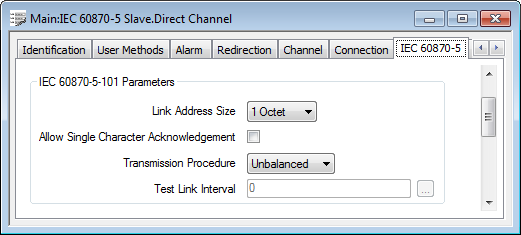When a Slave Channel is configured to use an IEC 60870-5-101Protocol Type (see Specify the IEC 60870-5 Communications Protocol), you need to configure these properties on the IEC 60870-5 tab:

- Link Address Size—Use the combo box to specify the number of octets that are used to transmit the link address in each Application Service Data Unit (ASDU).
- If the Transmission Procedure is Unbalanced, specify the Link Address Size that corresponds to the size of the Link Address that is to be used by the slave outstation(s) on this channel. Specify 1 Octet or 2 Octets, as appropriate. (You specify each slave outstation’s Link Address using the Link Address field on the Slave Direct Outstation Form (see Configure the IEC 60870-5-101 Parameters).)
- If the Transmission Procedure is Balanced (see below), the Link Address is optional, as the address is not needed to identify the slave outstation (Geo SCADA Expert). Therefore, with a Balanced transmission you can optionally specify 0 Octets.
- Allow Single Character Acknowledgment—The IEC 60870-5-101 protocol defines two types of message that the SCADA master, or Controlling Station, can send to a slave to acknowledge the receipt of a data packet.
- One message is a single-byte response. This is an efficient type of response, although it may be received spuriously if there is interference on the line.
- The other type of message is a response that contains between four and six bytes (depending on the Link Address Size). This response is less efficient, but is appropriate on channels that are operating in an environment that has interference.
- Select the Allow Single Character Acknowledgment check box if there is no interference. You should also select the check box if the SCADA master is to send a single-byte message to the slave outstation (Geo SCADA Expert), in response to each data packet that the SCADA master receives successfully.
- Clear the Allow Single Character Acknowledgment check box if the SCADA master is to send four- to six-byte acknowledgment messages in response to each data packet that it receives successfully from the slave outstation (Geo SCADA Expert).
- Transmission Procedure—Use to specify the transmission procedure that applies to the channel. Select the option that applies to your system setup:
- Unbalanced—The SCADA master controls the data traffic on this channel by scanning the channel’s outstations sequentially. The SCADA master initiates transmissions via the channel. None of the outstations on the channel can initiate transmissions—instead, they can transmit data only in response to a poll from the SCADA master.
- Balanced—The channel is used for point-to-point communications, whereby the SCADA master uses the channel to communicate with a single slave outstation. With a Balanced transmission procedure, the slave outstation (Geo SCADA Expert) can initiate communications with the SCADA master.
- Test Link Interval—Only applies if the Transmission Procedure is Balanced.
- With a Balanced transmission, there may be long periods of time during which no data is transmitted. The slave outstation (Geo SCADA Expert) can transmit test frames at specified intervals to determine whether the channel is still available.
- Use the Test Link Interval to specify the maximum amount of time, in seconds, that the Link Layer can remain idle, before the slave outstation is to send a test link frame to the SCADA master.
- Specify 0 if the slave outstation (Geo SCADA Expert) is not to send any test link frames via this channel.